— 16 min read
RFIs: A Contractor’s Guide to Requests for Information


Last Updated Oct 3, 2025

Hildy Medina
Jobsite Editor-in-Chief
Hildy Medina is the Editor-in-Chief of Jobsite. In her former life, Hildy was a journalist writing for various publications, including Forbes, The San Diego-Union Tribune, and The Santa Barbara News-Press.

Julia Tell
Contributing Writer
66 articles
Julia Tell is a freelance writer covering education, construction, healthcare, and digital transformation. She holds a Ph.D. in Media & Communications and has written for publications including Business Insider, GoodRx, and EdSurge, as well as nonprofits, international businesses, and educational institutions.
Last Updated Oct 3, 2025

If a general contractor could add up all the minutes they spent waiting on a response to a request for information (RFI) throughout their career, they might have found that they could have gone on vacation or even built a few shopping plazas, and they can be costly too. Research has shown that an average project on a typical day could have between 10–15 RFIs per $1 million in project value. This means a $5 million project can generate about $100,000 in costs.
RFIs are simply requests for information, yet, there’s nothing simple about them if they’re not handled properly. There are easy ways to successfully manage the RFI process and we’ll tell you how to do just that.
Table of contents
What is an RFI in construction?
An RFI is a business process used in construction to request clarification about documents, drawings, specifications or other project conditions. RFIs are used to resolve information gaps and eliminate ambiguities by capturing and sharing specific decisions made during the course of the project.
Contracts often require a notification when errors, conflicts or omissions are discovered, and an RFI is the tool used extensively in the construction industry. Not only does the RFI document a process, but it is also a contractual obligation and fundamental process for successful delivery of projects.
A general contractor or subcontractor usually submits an RFI in written form to retrieve information from a design, engineering or construction professional. The information requested through an RFI is typically information that wasn’t included (or was unclear) in the scope of the construction contract.
The Construction RFI Process Flow Chart
The primary goal of the RFI process is to eliminate the need for time-consuming and costly corrective action(s) during a project's life cycle. Typically, RFI questions are asked and resolved during a project's bidding process and/or during the project's course of construction.
The process of executing an RFI is fairly linear, although different project or design team members may need to be consulted depending on the issue the RFI is addressing. Sometimes, steps within the process require repetition to flesh out the issue and identify options for changes or gather additional details.
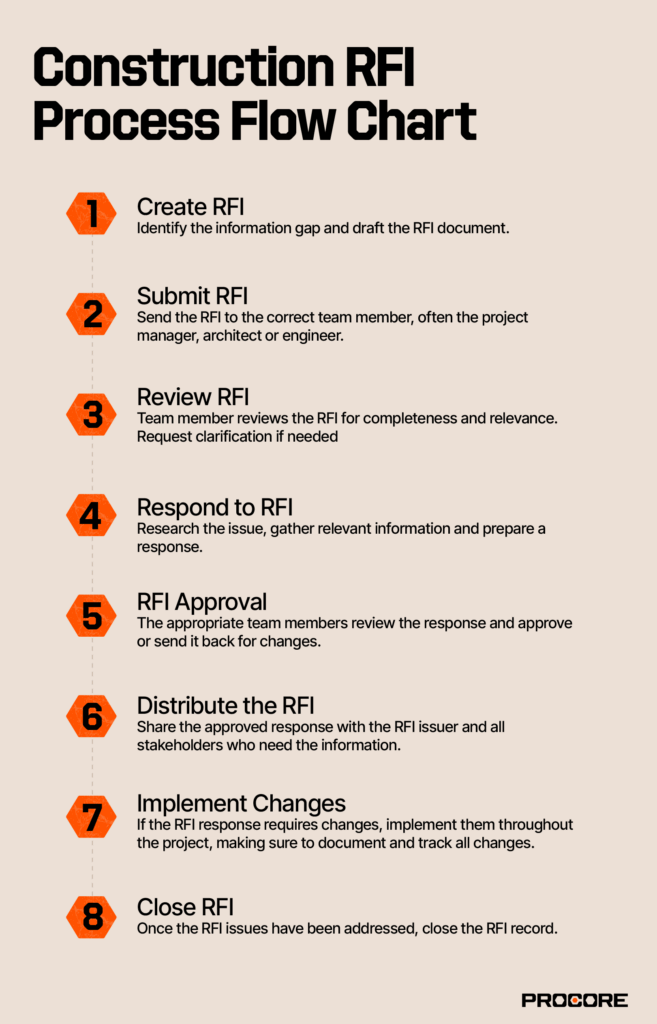
Different types of RFIs will follow this flow chart, with varying personnel responsible for actions on the steps in the process. Most often, the RFI will involve project managers, site personnel and design and engineering team members.
What to Include in an RFI
RFIs can be roughly classified into several different categories. These classifications can be valuable to the project team if broad categories are used in documents. This way, they can enhance communication, focus the process on the intended and desired result and steer the project team.
These categories are:
- Design clarifications: conflicts, incomplete plans, specifications
- Requests for a design change: often due to errors in construction, sequencing problems
- Requests for substitutions: value engineering, material availability, ease of use
- Differing site conditions
This list is not exhaustive, and it is more important to understand what an RFI is not. Many items are appropriate and necessary, but are better transmitted or communicated via other methods.
An RFI is not intended to be used for routine communication, submittals, a safety plan or schedule, transmittal or a documentation method. RFIs should never replace verbal communication or be used for commentary or positioning.
On the design side, RFIs should not be used for the incremental issuance of design documents that should have been part of the award (design/build or fast-track design excepted). Dependent on the contract, RFIs may or may not be used for substitutions.
Free Download
General RFI Template
Download and customize a general-use RFI template to request more detail or clarification about drawings, specifications, schedules — or get answers to any questions about a project.
- For use on projects when an RFI form is not specified
- Ready-to-use
- Designed specifically for construction
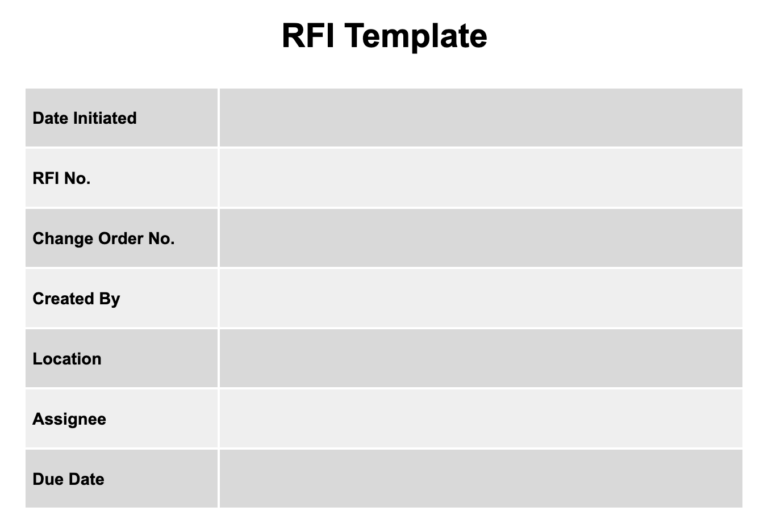

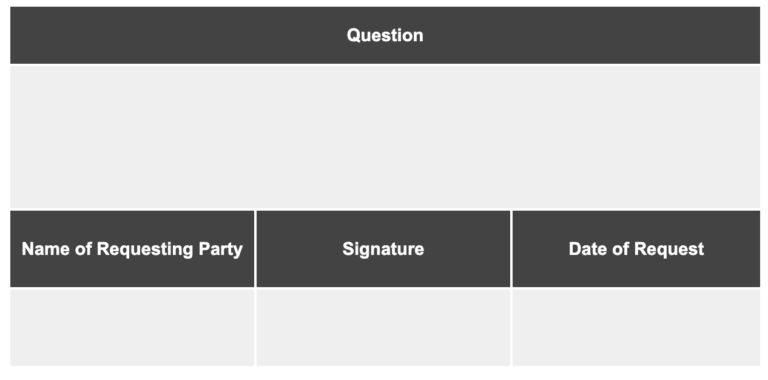
Free Download
RFI Log Template
General contractors and design teams use an RFI log to track RFIs submitted throughout the construction project, along with the responses received and the status of each request. Download and customize this RFI log template to track RFIs submitted throughout a project.
- Customizable to project requirements
- Ready-to-use
- Made by and for construction professionals
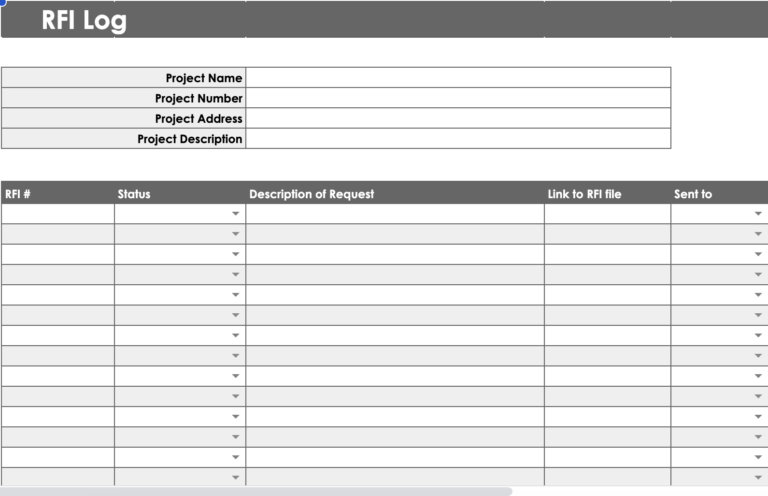

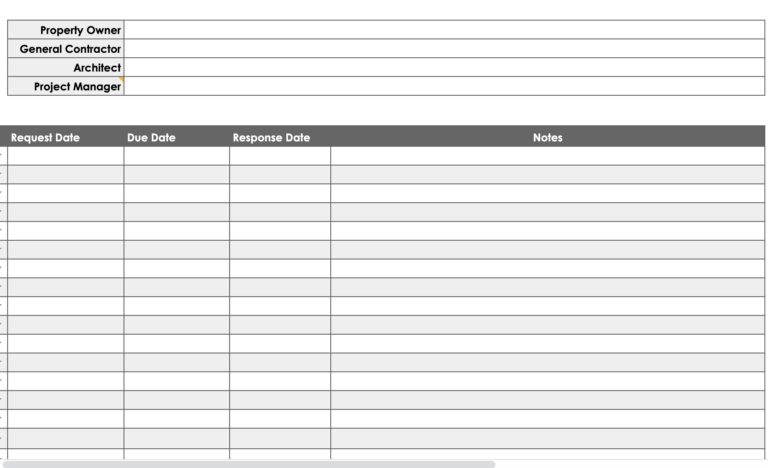
If your contract has a separate process, make certain that paperwork and process are used. If not, use the RFI process and identify the RFI as a ‘Request for Substitution’. Do not use the RFI for approval of means and methods or contract problems. It is also not an outlet to ask inappropriate questions related to product installation typically specified by a manufacturer. Do not consider an RFI as a construction change directive or a change order request.
In regards to contract requirements, make certain that the project general condition requirements are well known by the construction team and follow them. Federal and Governmental contracts are particularly known for contractually fixed processes that vary greatly from owner to owner.
Using an RFI Template
These RFI templates were created by construction professionals to help contractors and project owners manage requests for information on a project. Project participants can use these forms to request additional information or clarify ambiguous specifications, and track the responses and status of each request.
Free Download
General RFI Template
Download and customize a general-use RFI template to request more detail or clarification about drawings, specifications, schedules — or get answers to any questions about a project.
- For use on projects when an RFI form is not specified
- Ready-to-use
- Designed specifically for construction



Free Download
RFI Log Template
General contractors and design teams use an RFI log to track RFIs submitted throughout the construction project, along with the responses received and the status of each request. Download and customize this RFI log template to track RFIs submitted throughout a project.
- Customizable to project requirements
- Ready-to-use
- Made by and for construction professionals



RFI vs. Other Types of Requests
The most common "request for" documents besides the RFI are the request for proposal (RFP) and the RFQ, which can stand for "request for qualifications" or "request for quote."
RFIs are often issued at the beginning of the process. An RFI is similar in some ways to an RFP, but is usually less rigorous and contains fewer questions.
An RFP initiates the procurement process by asking vendors to respond to a questionnaire based on the organization's needs, leading to scoring and potential further negotiations. An RFQ is used to make sure vendors meet specific criteria by requesting detailed information, often in a statement of qualifications. Alternatively, an RFQ can also mean "request for quote," which asks vendors for pricing details on standardized goods or services, typically following the RFP stage.
Biggest Challenges in the RFI Process
One of the major problems with RFIs is the additional cost burden they can place on a construction job. It might not seem like much initially, but the delays, downtime and costs that result from an RFI can add up over time.
In 2013, Navigant Consulting conducted a study on the impact of RFIs in construction, reviewing data from 1,362 projects worldwide with more than 1 million RFIs. The study found that responding to an individual RFI costs construction firms an average of $1,080. The collective cost to the project could set a firm back $859,000. And with time these costs have no doubt grown.
The research revealed that RFIs can create significant backlogs, since owners and project managers are required to review and respond to each individual RFI from contractors and subcontractors, noting the cost of each one and the use of the process to make claims against owners.
In addition, whether due to requests not considered by the design team, questions already answered in the original contract, or because they are focused on means and methods, more than one in ten of the RFIs were listed as "unjustifiable." Collectively, these unjustified RFIs averaged about $113,400 per project.
Perhaps the most troubling data uncovered in the Navigent research is that nearly one out of every four RFIs receives no reply. Without someone replying and solving the problems associated with an RFI, it can lead to shoddy craftsmanship, improper construction and even a potentially unsafe structure.
With clients becoming more litigious every year, it's vitally important that construction firms build these structures using the full scope and requirements laid forth by the engineers and architects, otherwise, there's a very real chance the construction firm can ultimately face a lawsuit over a poorly constructed building.
Best Practices to Improve the RFI Process
One of the main causes of RFIs is the lack of communication between architects, engineers, contractors and other key stakeholders.
As each of these groups becomes more technical and isolated, the less overlap and interaction occurs between them. This siloed nature means the builder at the tail end of the process will need to request information from someone further up the design chain, ultimately leading to a loss of time and working hours as well as increased costs.
Generally speaking, most businesses or owners will try to set their RFI best practices and expectations prior to beginning a project. These RFI best practices include:
- Developing an RFI procedure
- Defining what constitutes an RFI (and what doesn't)
- Outlining the documentation required along with an RFI for a response
- Defining expected response times
- Communicating the process and requirements to all stakeholders
There are a few more things contractors can do to make sure the RFI process flows as smoothly as possible.
Free Course: Basics of RFIs
Learn the key principles of RFIs from the pros and earn continuing education credits from AIA.

Make clear requests.
It’s surprising how often the most basic elements go missing from the RFI, puzzling the recipient and creating unnecessary drag in the process. Make the “request” as obvious and unadorned and specific as possible. Each question should be singular and clear — and answerable.
Follow each question with a question mark, as a way of separating issues and focusing on the exact nature of the request. Getting fancy with the questions or trying to intermingle several issues at once in the RFI doesn’t move the ball downfield. Keep it simple. An RFI is a question. Ask it as plainly as possible.
Add essential context.
It is very easy to accidentally compose a request that draws so much from someone's own experience of the issue, it defies easy penetration by the recipient. That is a time-eater. Construct the question in such a way that absolutely anyone on or off the project can understand it. Look closely at the request. Does it even mildly presume some prior knowledge on the recipient’s part?
A proper contextual RFI should include:
- The exact nature of the misunderstanding
- A description of parties impacted
- The part of the project process that is impacted
- Where on the build the information is lacking
- A deadline by which a response is needed
An issue doesn’t present in isolation on a project, and neither should its corresponding RFI. Wrap the question lightly in the sort of augmenting detail that brings complete clarity to the RFI.
Use a real-time solution.
Contractors who implement software for managing RFIs can effectively eliminate these delays by making them available to all relevant parties instantly. Anyone on the team — from executives to architects to subcontractors in the field — can easily snap a photo of the problematic area and upload it to the platform for everyone else to view. Even individuals who do not have the platform can receive a message alerting them to the issue.
Project managers can then review the RFI in real time and notify the necessary individuals all with a few clicks and swipes from their mobile devices. When everyone has real-time access to RFIs along with pictures of the request or problematic areas, construction firms can reduce the time and manpower associated with this necessary component of the building process.
With the right software solution, RFIs can be sent to everyone who needs to respond — no matter where they are. Employees in the field can attach photos, drawings or schematics that are more detailed and specific to the request. More comprehensive information gives the recipient a better understanding of the RFI and can speed up the decision or response process.
And once a response is received, the right software solution will archive all the activity involved around it, and if needed, help initiate a change order and manage the intricate processes that evolve from there. Using technology to take the "menial" out of the process and allows for more time to plan ahead for future issues.
Expect responses in realistic timeframes.
Read the contract thoroughly to understand what qualifies as an RFI and what does not according to the agreement. Many RFIs are already answered within the original contract documents.
In addition, don’t be caught off guard if you get a response from a request that indicates the recipient has an “allotted” amount of time to respond to your request. Many current contracts are now defining timeframes for response rates based on the recipient. For example, “engineer is given a maximum of seven days to respond to the RFI.”
Based on feedback from interviewed construction firm staff, design professionals estimate that the average RFI would require about eight hours to receive, log, review and respond. While many requests can be fielded and replied to within an hour, others may take days to research and provide an appropriate response. According a Navigant study, average RFI reply times can range from 6.4 days to 10 days based on region, project size and duration.
Dependent on the discipline involved in the request, a paint color question would be easier to answer than an engineering question. Understanding those differences, it’s important to think ahead.
Clarifying what is “mission critical” and what can be placed on the back burner will go a long way in helping answers get fast-tracked. Be specific in your requests, and level them according to project urgency. Marking RFIs as “high-priority” can help increase response times, but be sure not to cry wolf too many times. If everything is urgent, then nothing is.
Group related requests together.
Submitting an RFI when the condition is critical will more than likely result in delays. However, reviewing foreseeable issues and sending RFIs ahead of time leaves you ample breathing room for getting a response in time for the job related to the question at hand to be completed.
If you realize that certain categories are requiring more clarification, then grouping issues may help speed up RFI response times for difficult aspects of a project.
Include photo documentation.
A picture is worth 1,000 words. This truism is perfectly suited to the RFI. Attaching photos, drawings, video or even a hastily sketched diagram will go a long way toward eliminating confusion about the exact nature of the information being requested.
Visuals have a way of cutting straight to the chase, and when combined with your focused questions will assure the RFI is addressed quickly and accurately.
Don't use RFIs as a weapon.
Using the RFIs to indicate a company’s or owner’s lack of diligence or liability for additional time and costs may not get you far in court. Construction companies have attempted to use the sheer volume of RFIs as a way of showing faulty plans. However, in one case the court ruled that “...a large number of RFIs is not an indication that the plans were defective…” and “...in order for the RFIs to be evidence that the plans were defective, they must cumulatively demonstrate a serious deficiency in the plans.”
Another court case, Dugan & Meyers Construction Co., Inc. v. Ohio Department of Administrative Services, resulted in Dugan & Meyers losing in appeals because Ohio courts have rejected cumulative impact arguments (the impact of a series of changes on productivity, schedule and cost). While this court case is state specific, it’s still important to understand current thinking behind cumulative impact and RFIs.
In the future, the burden of demonstrating delay and impact beyond the quantity of RFIs submitted will rest on the contractor’s shoulders. And with mounting court case appeals in favor of the defendants, RFI processes must be more thorough along with detailed documentation and proof of true impact if the contractor wants to litigate over damages.
Suggest a solution.
Suggesting a solution not only frames and highlights the central issue of the RFI, that format will also serve to spur the recipient to an immediate "solution mode" — turning an "I'll have a look at this later" item into an action item.
If you’re in the position to request an RFI, you likely have the professional expertise and situational awareness to include with your very specific question a couple of possible answers of your own. What’s the point of submitting a proposed answer alongside your own question? This practice serves to bring the question into even sharper relief by contrasting the RFI against a rhetorically proposed solution. It’s like darkening the background of a photo in order to helpfully exaggerate the outlines of the subject. You do not have the answers, clearly, or you wouldn’t be producing an RFI.
This is where technology can be your friend. Using a mobile-enabled, collaborative software solution can help streamline communications and keep everyone informed in real-time.
Types of RFIs & Involved Roles
RFIs can originate from various parties and request different types of information. Each type of RFI involves specific roles depending on the nature of the information being requested, and providing the appropriate expertise throughout the process.
Design Clarification RFIs
- Originator: Contractor or Subcontractor
- RFI Creation: Site Engineer or Project Engineer drafts the RFI.
- RFI Submission: Submitted to the Project Manager.
- RFI Review: Project Manager reviews and forwards to the Architect or Design Consultant.
- RFI Response: Architect or Design Consultant prepares and approves the response.
- RFI Distribution: Project Manager disseminates the response to relevant parties.
- RFI Implementation: Site Engineer implements changes as per the response.
Material Specification RFIs
- Originator: Supplier or Subcontractor
- RFI Creation: Procurement Officer or Project Engineer drafts the RFI.
- RFI Submission: Submitted to the Project Manager or Construction Manager.
- RFI Review: Project Manager reviews and forwards to the Materials Engineer or Architect.
- RFI Response: Materials Engineer or Architect prepares and approves the response.
- RFI Distribution: Project Manager or Administrative Staff distributes the response.
- RFI Implementation: Procurement Officer and Site Engineer ensure compliance with the response.
Site Condition RFIs
- Originator: Contractor or Site Personnel
- RFI Creation: Site Engineer or Foreman drafts the RFI.
- RFI Submission: Submitted to the Project Manager.
- RFI Review: Project Manager reviews and consults with Geotechnical Engineer or Civil Engineer.
- RFI Response: Geotechnical Engineer or Civil Engineer prepares and approves the response.
- RFI Distribution: Project Manager disseminates the response to relevant parties.
- RFI Implementation: Site Engineer and Construction Team act on the response.
Schedule and Timeline RFIs
- Originator: Contractor or Scheduler
- RFI Creation: Project Scheduler or Site Engineer drafts the RFI.
- RFI Submission: Submitted to the Project Manager.
- RFI Review: Project Manager reviews and coordinates with the Planning Engineer.
- RFI Response: Planning Engineer prepares and approves the response.
- RFI Distribution: Project Manager or Administrative Staff distributes the response.
- RFI Implementation: Project Scheduler and Site Engineer adjust plans based on the response.
Regulatory Compliance RFIs
- Originator: Contractor or Compliance Officer
- RFI Creation: Compliance Officer or Project Engineer drafts the RFI.
- RFI Submission: Submitted to the Project Manager.
- RFI Review: Project Manager reviews and liaises with Legal Advisor or Compliance Consultant.
- RFI Response: Legal Advisor or Compliance Consultant prepares and approves the response.
- RFI Distribution: Project Manager or Administrative Staff distributes the response.
- RFI Implementation: Compliance Officer and Site Engineer ensure adherence to the response.
Streamline RFIs to improve outcomes.
Remember that RFIs are not submittals, change orders or contracts. While they are important, and you need answers fast, you can safeguard yourself and your sanity by planning ahead and instituting reasonable response rates, engaging in best practices and implementing innovative software solutions. These all equate to less time waiting and more time working.
If the construction project owner, company or construction manager is using software to track and respond to RFIs, ask for training to use the system properly. If you are the one introducing the system, make sure the owner, company or project manager understands the need for real-time collaboration to keep the project on time and within budget.
Often the project management system or solution you’ll be expected to utilize is outlined in your contracts — so again, read those contracts carefully.
Stay updated on what’s happening in construction.
Subscribe to Blueprint, Procore’s free construction newsletter, to get content from industry experts delivered straight to your inbox.

Was this article helpful?
Thank you for your submission.
88%
12%
You voted that this article was . Was this a mistake? If so, change your vote
Scroll less, learn more about construction.
Subscribe to The Blueprint, Procore’s construction newsletter, to get content from industry experts delivered straight to your inbox.
By clicking this button, you agree to our Privacy Notice and Terms of Service.
Thank you!
You’re signed up to receive The Blueprint newsletter from Procore. You can unsubscribe at any time.
Categories:
Written by

Hildy Medina
Jobsite Editor-in-Chief | Procore
Hildy Medina is the Editor-in-Chief of Jobsite. In her former life, Hildy was a journalist writing for various publications, including Forbes, The San Diego-Union Tribune, and The Santa Barbara News-Press.
View profile
Julia Tell
Contributing Writer | Procore Technologies
66 articles
Julia Tell is a freelance writer covering education, construction, healthcare, and digital transformation. She holds a Ph.D. in Media & Communications and has written for publications including Business Insider, GoodRx, and EdSurge, as well as nonprofits, international businesses, and educational institutions.
View profileExplore more helpful resources

Automation in Construction: Transforming the Future of Building
Technological advancements empower the construction industry to tackle complex projects and drive the global demand for sustainable, feature-rich structures technology makes possible. From design to closeout, construction automation is enabling...

Bid Management Software: Key Features & How to Choose the Right Fit
Bidding on construction projects can be a complex process. Sourcing appropriate bids and requests for proposals, analyzing bid documents, making sure estimates, preliminary schedules, and other mandatory requirements are met...

From “What Is” to “What If” in Construction
In this episode of The Power of Construction, futurist Nikolas Badminton challenges the industry to reimagine what’s possible when we move from “what is” to “what if.” Rather than planning...

Transforming Construction Project Management With Predictive Analytics
Construction leaders who can correctly identify project challenges before they arise can more easily sidestep them. This saves time, money and significant delays. Predictive analytics attempts to forecast future outcomes...
Free Tools
Calculators
Use our calculators to estimate the cost of construction materials for your next project.
Templates
Find a template to help you with your construction project tasks.
Material Price Tracker
Get the latest U.S. retail prices and view historical trends for common building materials.
Glossary
Explore key terms and phrases used in the industry.
